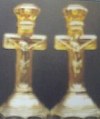Carnival Glass 101 | home Quick Reference to Carnival Glass Patterns on This Site
Higbee Glass
HIGBEE GLASS
Examples in this segment are all very scarce in iridized form. Higbee, McKee and Heisey Glass Companies produced pressed glass but were not known to iridize glass. They sold small lots to after-market iridizers, who then sold their wares more or less privately. Some outlets were from private homes, where the iridizing took place on the premises.
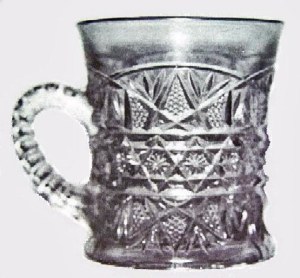
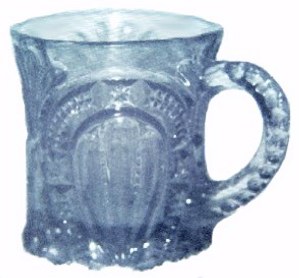
TEN POINTED STAR and RIBBED ELIPSE
TEN POINTED STAR: John and Lucile Britt of Manhattan, KS were among the earliest of “carnival glass searchers and researchers”, dating back to the time of Dick and Emma Tilton of Ohio, in the 1950's. Those two couples have owned more glass than one can imagine, during their prime collecting years. They would team up for scouting purposes and then John would research and talk with people who could inform him of facets about the Glass which had not yet been recorded in books at that time. He always enjoyed mugs and tumblers as much as any of the many shapes available in carnival glass, and as a direct result of that intense interest, his written accounts of many items have never been expounded upon. He and Lucile owned many one-of-a-kinds. Thank God, he was astute and felt the importance of detail. To that end, his written accounts of many patterns remain the only ones on record today!
Thankfully, we have saved a great many of John's written accounts over the past 25 years, because background information on the Glass has always been of prime importance to us, as well! With that in mind, we take pleasure in passing along to newcomers and those who may not have had the advantage of knowing these folks; or otherwise benefited from reading the tremendous accounts of such treasured pieces as this little mug!
John and Lucile write: “We recently picked up a mug that we knew nothing about and had never seen before.
Karen Skinner, of East Alton, IL found the pattern of this mug from a photo we had sent to her. The pattern is called Ten Pointed Star and is shown in Kamm Book #2 on page 62. It is shown there in the water pitcher. All of Kamm's description of the pitcher fit the mug very well. The same type of handle is used on both examples and both have the same design on the bottom of the base.
The TEN POINTED STAR mug has a honey amber color with nice iridescence. It is 3 ¼” high with a top opening of 2 7/8” in diameter and is depressed in about ¼”. The base is 2 5/8” in diameter and is depressed in about ¼”. There is an unusual and different eight pointed star within the marie. A row of deep thumbprints decorates both sides of the handle. The pattern covers most of the outside surface except for a small smooth area at the top edge. The mug is more narrow in center than at the top and base.
This is a Higbee pattern. William Heacock wrote an article on early Higbee patterns for his Pattern Glass Review, issue #1. Some other Higbee pattern glass pieces which we have seen with iridescence are two old Paneled Thistle tumblers, several Ribbed Elipse mugs and tumblers, several Palm Leaf and Fan pieces and Fine Cut and Fan items. We have a few examples of the latter two patterns in small child's type dishes. One is a 5 ½” hand grip plate in the Palm Leaf and Fan pattern, having beautiful marigold with very nice iridescence. Iridized old patterns from this manufacturer are few and far between.”
RIBBED ELIPSE: This pattern is not included in any previous books written specifically about carnival glass. The pattern is described in Kamm's Book 5, page 70, and is known to be a Higbee product, according to research done by John Britt prior to 1990. Wm. Heacock included an article on Higbee Glass in the April 1981 Glass Review Magazine. The Ribbed Elipse pattern is also discussed, along with a photo of it, in the Oct. 1981 issue of that same magazine, in an article about cruets written by Mary Armonino Early.
The Higbee factory closed in 1916. This confirms they were producing glass during most of the prime carnival glass years. This mug is of standard size and the color was of amber-marigold, having fine iridescence. Thus far, at least two of these have been found.
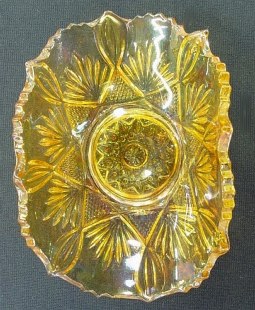
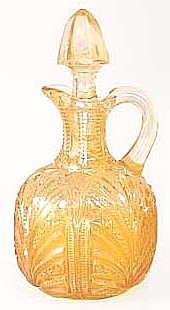
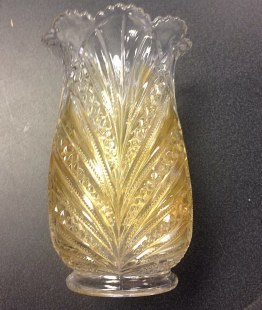
Left - Fine Cut Star and Fan Banana Boat - Courtesy Jim Wroda.
Middle - Diamond Fountain Cruet.
Right - Diamond Fountain Celery Vase - Courtesy Greg Ferguson.
FINE CUT STAR & FAN: appeared in the Nov. 13, 2004 Wroda sale in Greenville, OH. in this five and a half inch banana shaped dish. For lack of information surrounding its origin, the selling price was a mere $27.50. The marigold overlay was of brilliant quality. In our 30 years with this glass, we had not seen the pattern before in carnival glass. Notoriety is everything, when it comes to placing rarity status! Unless written matter and promotional discussion leads to acceptance of any obscure example, little notice is given to such pieces.
DIAMOND FOUNTAIN Cruet: The first time we saw one of these cruets was in the Northern Ca. collection of Jim and Marie Capps, during the late 1980s. The marigold overlay was quite pale, but the cutwork design is exquisite! We did not think to measure the cruet, but thinking back on it, believe it must be between 5 ½”-6” in height. An ad for this cruet in crystal form, appeared in a 1910 Higbee publication. Opportunities to see one of these are virtually non-existent. Hundreds of carnival glass auctions are held each year, to say nothing of the hundreds more pieces displayed on eBay and sold through small local auctions all over the Country, with little opportunity to pick up such rarities as those seen in this segment.
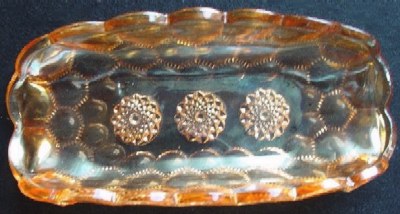
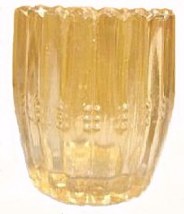
Left - This piece is said to closely resemble SAWTOOTHED HONEYCOMB. Courtesy Lance Hilkene.
Right - BANDED BARREL Toothpick in Marigold-1889 -1910 - 2.25 in. tall x 2 in. wide.
A Close Resemblance to SAWTOOTHED HONEYCOMB: was the explanation for this piece owned by Lance and Pat Hilkene of New Jersey. Dean photographed it in their room while attending the 2005 Woodsland Convention in Columbus, OH. According to the Edwards & Carwile Standard Encyclopedia of Pressed Glass, this pattern was originally produced by Steiner Glass of West Virginia and then by Union Stopper in 1908. Neither of these houses were known to have produced iridized wares. However, one or both manufacturers produced this pattern in nappies with Bernheimer Brothers advertising. Just why this one iridized example has surfaced is not known at this time. For lack of a better place to display this “one-of-a-kind”, we have placed it here with some known Higbee patterns. If you have any specific information surrounding the matter, we would all enjoy hearing from you!
NOTE: Should further iridized examples from Higbee production become available, we will update and extend this segment. Perhaps some of our readers have pertinent fact surrounding such patterns? We would appreciate hearing from you.
BANDED BARREL: Items from Higbee Glass which have been iridized, by other means than at factory level, are few and far between, identifiable from Glass Company records of pattern only. So few examples from that manufacturer are within the iridized category that authors have not made mention of them to any large degree. The 1889-1910 attached to this toothpick designation likely refers to overall production of the pattern. Seems reasonable to assume that the few iridized examples would have occurred between 1908 -1912.
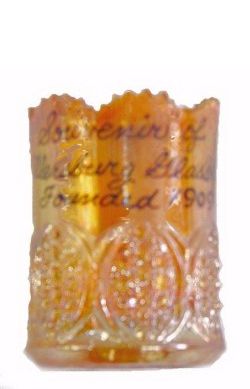
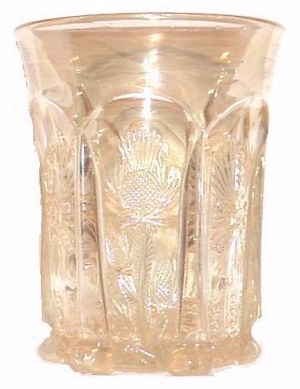
Left - 1 1/2 in. Toothpick - (Souvenir of Millersburg Glass Co. Founded 1909) - sold in Wroda Auction.
Right - Higbee PANELED THISTLE - has no Bee on the interior. - Courtesy Bob Smith.
SOUVENIR of Millersburg Glass Co. Founded 1909: Dean photographed this neat little piece prior to the March 11, 2006 Wroda Auction in Greenville, OH when a collection from NC sold. We could not locate the pattern among those displayed in the McKee Glass book written by Sandra Stout. Reportedly, these are reproductions of the old Button Arches pattern, made by Summit Glass c. 1980s-1990s. They have been found having Cambridge and Heisey lettering with respective founding dates as well. Did Summit perform the lettering task, or is it another example of “after market” application? The Millersburg Museum sold examples, according to one report, so perhaps the Cambridge and Heisey Museums did so?
UPDATE: Re: Millersburg Toothpick.
An email from Jerry and Carol Curtis on April 12, 2006 offers some insight into this “script-written advertising toothpick”.
“While on an antiquing trip in 1986, we went to Millersburg and picked up a few pieces while there. When we asked around, someone referred us to the “Millersburg Museum”, which was “temporarily” located in an old rundown house. When the elderly lady answered the door, we went inside, whereupon she told us she was the owner of the “museum”. I keep highlighting that word for it was really a couple of rooms that held some glass and photos. Among the pieces we saw were a couple of these souvenir toothpicks in vaseline glass with a good marigold iridescence. The lady didn’t want to sell us one but finally relented and parted with just one. She told us she had those pieces manufactured and iridized and had sold them out of her museum. She said that we had just bought the last one that would be sold. She didn’t say just how many were made or sold but I would be surprised (due to the conditions of the lady and her house), that she had very many made. She also didn’t say who had made them for her.
Anyway, it is a real neat conversation piece and we don’t care to part with ours anytime soon for we are sure they are pretty scarce.”
PANELED THISTLE: The light marigold tumbler example shown is Courtesy Bob Smith. He bought it years ago from John Britt, on the strength that Cecil Whitley had owned one for years. There is no bee trademark in the interior base. This is somewhat strange, since the iridized pink celery holders in this pattern, which were reproduced from the old mould during the `70s, do carry the bee trademark. Apparently all the old moulds were not trademarked.
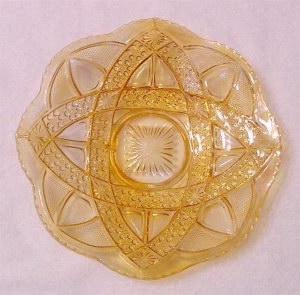
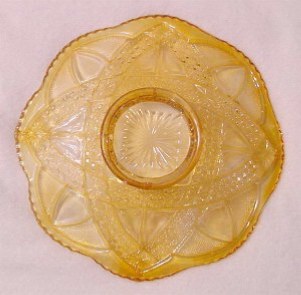
Twin Teardrops or Anona - Courtesy Jerry & Carol Curtis.
Interior surface is smooth. Reverse displays the pattern and amber base glass.
TWIN TEARDROPS or ANONA: Jerry and Carol Curtis have been in the process of moving from CO to TX. Tired of “work”, they decided to do a little antiquing one day in mid Feb. 2006. Carol found this unusual amber plate in a pattern unknown by them. Inquiries into its origin via the Woodsland Club mailing list, brought the following information from a member who calls herself Lin F.
A search in a book of Bryce, Higbee and J.B. Higbee Glass, a Pennsylvania pressed glass company identifies the 9” plate as Twin Teardrops or Anona on page 95. Manufacture was circa 1905-1907. The authors of this book: Lola & Wayne Higby.
The Encyclopedia of Pressed Glass by John & Elizabeth Welker also refers to the plate Curtis' say measures 9” across the more narrow points of the surface and 9 ¼” from scallop to scallop. There is a collar base-not ground, with the incised pattern appearing on the exterior. Interior surface is smooth.
Dean & Diane Fry - 4/06





Bless the Lord, O my soul, and forget not all His benefits. ------ Psalm 103:28
Blessed be the Lord, who daily loads us with benefits ------ Psalm 68:19





Should you care to contact the Frys, their email address is:
Search Our Sites
back to Carnival Glass 101
Our other sites you may enjoy:
Everything you EVER wanted to know about Indiana Glass
Great Reference for Newer Carnival Glass.
Complete Glassware Catalogs Available to Download
Questions? Comments? Suggestions? Broken Links? Corrections?
Your Friendly Webmaster is here to help!
